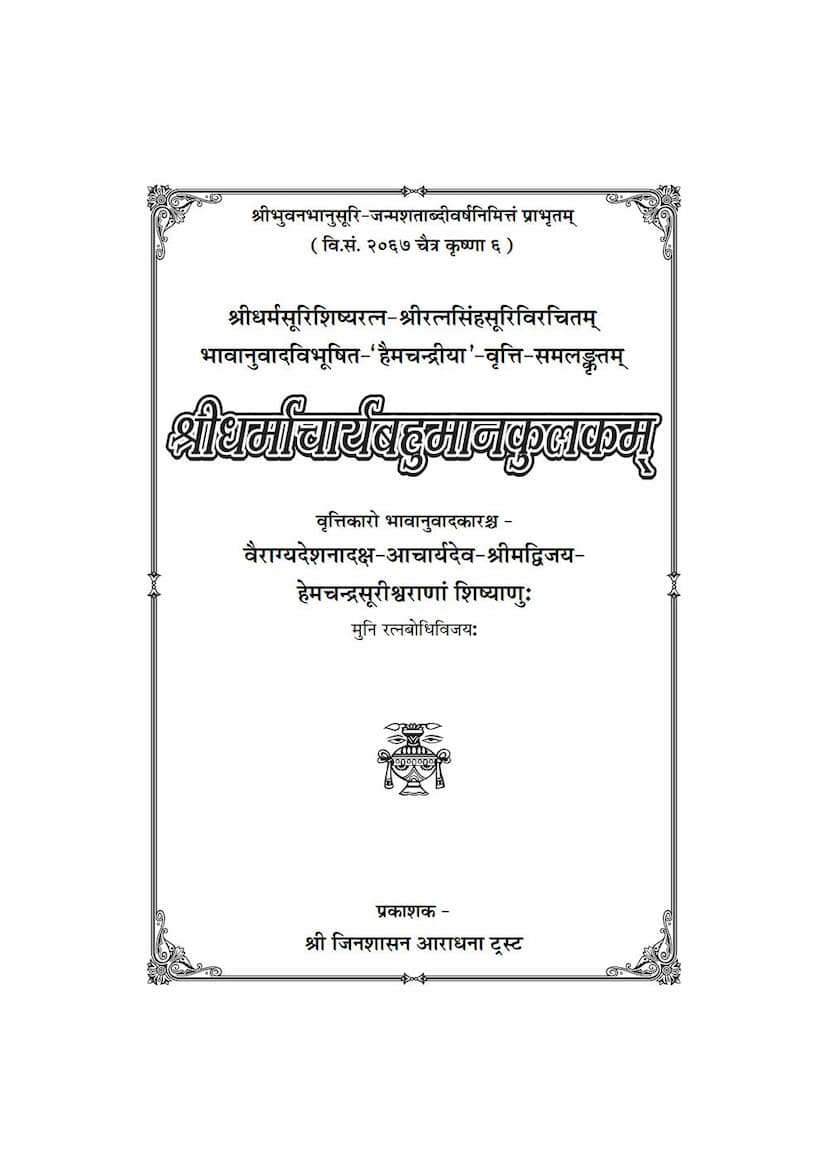Dharmacharyabahumankulakam
Added to library: September 1, 2025

Summary
"Dharmacharya Bahuman Kulak," authored by Ratnasinhsuri and Ratnabodhivijay and published by Jinshasan Aradhana Trust, is a Jain text that delves deeply into the concept of reverence and devotion towards one's spiritual teacher (Guru). The book, annotated and explained with a commentary known as "Haichandriya Vritti" by Muni Ratnabodhivijay, aims to elucidate the profound significance of a disciple's relationship with their Guru.
The text is structured around a series of verses (shlokas) that expound on various facets of Guru devotion, each elaborated upon in the commentary. The central theme revolves around the idea that true discipleship involves not just outward service but a deep-seated reverence and internalization of the Guru's teachings and spirit.
Key themes and concepts explored in the book include:
- The Paramountcy of Guru Devotion: The text repeatedly emphasizes that Guru devotion is the highest form of dharma and the most crucial path to liberation. It highlights that even celestial beings like Indra and enlightened beings like Kevalins show reverence to their Gurus.
- The Nature of True Discipleship: A true disciple is portrayed as one who not only follows the Guru's commands but also strives to understand and fulfill the Guru's inner desires and intentions through intuition and foresight. This involves sacrificing personal desires and aligning one's life with the Guru's vision.
- The Role of the Guru: Gurus are depicted as guides who illuminate the path to liberation, akin to a spiritual parent and a beacon of knowledge. They are seen as instrumental in removing ignorance, overcoming obstacles, and leading disciples towards spiritual progress. The text asserts that a Guru's role is multifaceted, encompassing teaching, guidance, and the removal of karmic obstacles.
- The Importance of Reverence and Humility: The text stresses the need for unwavering reverence, humility, and obedience towards the Guru, even if the Guru's actions seem perplexing or unfavorable from a worldly perspective. It uses various analogies to illustrate that devotion, even when seemingly difficult, ultimately leads to spiritual growth.
- The Dangers of Disrespect and Neglect: The text strongly warns against any form of disrespect or neglect towards the Guru, likening it to spiritual suicide or inviting great peril. It emphasizes that the Guru's grace is essential for spiritual progress, and any deviation from this path leads to ruin.
- The Illustrative Power of Examples: Throughout the text, numerous examples from Jain scriptures and tradition are cited, such as those of Gautam Swami, Ekplavya, Shravika Sulsa, and others, to reinforce the teachings and demonstrate the profound impact of Guru devotion. These stories serve to illustrate the principles of discipleship and the consequences of adhering to or deviating from them.
- The Disciple's Inner State: The commentary highlights that external actions of devotion are secondary to the disciple's inner state of reverence, love, and surrender towards the Guru. True devotion stems from a sincere and unwavering heart.
- The Concept of 'Bhav' (Inner Feeling): The text places a strong emphasis on the 'bhava' or inner feeling behind actions. Actions performed with sincere devotion are meritorious, while those done merely for show or ulterior motives are considered futile.
In essence, "Dharmacharya Bahuman Kulak" serves as a guide for spiritual aspirants, underscoring the indispensable role of a Guru in the Jain path to liberation. It advocates for a deep, sincere, and unwavering devotion to the Guru, not merely as an external act but as a transformative internal state that purifies the disciple and leads them towards ultimate spiritual realization. The commentary by Muni Ratnabodhivijay further enriches the text by providing a detailed interpretation and practical application of these profound spiritual principles.